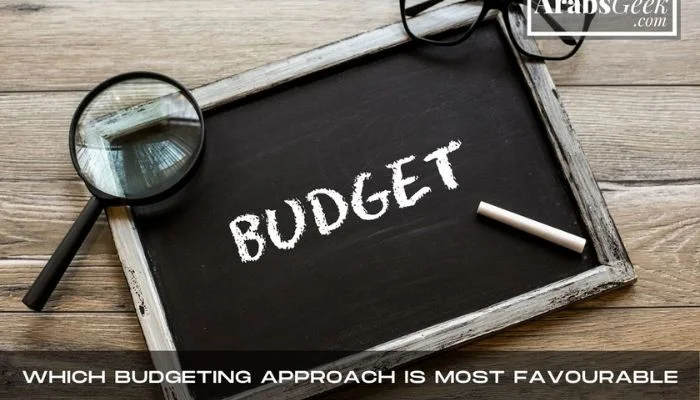Introduction | Which Budgeting Approach Is Most Favourable
The importance of budgeting
Budgeting is a critical aspect of financial management that helps organizations plan, allocate resources, and control expenses. Effective budgeting allows businesses to anticipate financial needs, monitor performance, and make informed decisions.
Table of Contents
Common budgeting approaches
Various budgeting approaches exist, each with its own set of advantages and disadvantages. Selecting the most favourable approach depends on factors such as the organization’s size, industry, complexity, and culture.
For any business enquiry, you can contact us at ArabsGeek.com
For more of such financial articles, Consider visiting our sister website at EntrepreneursPilot.com
Types of Budgeting Approaches
Traditional (Incremental) Budgeting
Traditional or incremental budgeting involves adjusting the previous year’s budget by a predetermined percentage to account for changes in costs and revenues.
Pros
- Easy to understand and implement
- Requires less time and effort than other approaches
- Provides a stable and consistent framework for financial planning
Cons
- May not accurately reflect the organization’s current needs or priorities
- Can perpetuate inefficiencies and wasteful spending
- May discourage innovation and improvement
Zero-Based Budgeting
Zero-based budgeting (ZBB) requires organizations to justify all expenses from scratch for each budgeting period, rather than relying on historical data.
Pros
- Encourages a thorough review of all expenses
- Helps identify and eliminate unnecessary or outdated costs
- Can lead to improved resource allocation and increased efficiency
Cons
- Time-consuming and labour-intensive
- May be challenging for large or complex organizations
- Can create tension among departments competing for resources
Activity-Based Budgeting | Which Budgeting Approach Is Most Favourable
Activity-based budgeting (ABB) focuses on the costs of specific activities or processes within the organization, linking expenses directly to outputs and outcomes.
Pros
- Provides a clear connection between costs and results
- Enables better understanding of cost drivers and resource allocation
- Facilitates continuous improvement and cost reduction efforts
Cons
- Can be complex and time-consuming to implement
- May require significant changes to organizational processes and systems
- Not suitable for all types of businesses or industries
Value-Based Budgeting | Which Budgeting Approach Is Most Favourable
Value-based budgeting prioritizes expenses based on their potential to generate value for the organization, such as increased revenue, customer satisfaction, or competitive advantage.
Pros
- Aligns budget with strategic objectives and value creation
- Encourages long-term thinking and investment in growth opportunities
- Helps to optimize resource allocation for maximum impact
Cons
- Can be challenging to quantify the value of certain initiatives or projects
- May require a significant shift in organizational culture and mindset
- Could lead to short-term sacrifices for long-term gains
Factors to Consider in Choosing a Budgeting Approach
Size of the organization | Which Budgeting Approach Is Most Favourable
Larger organizations may benefit from more sophisticated budgeting approaches, such as ABB or ZBB, while smaller businesses might find traditional or value-based budgeting more suitable.
Industry and market conditions
Organizations operating in dynamic or rapidly changing industries may need a more flexible and adaptive budgeting approach, such as ZBB or value-based budgeting.
Complexity of the business
Businesses with multiple products, services, or divisions may require a more detailed and granular budgeting approach, such as ABB or ZBB, to effectively manage costs and allocate resources.
Organizational culture and management style
The success of a budgeting approach often depends on the organization’s culture and management style. For example, value-based budgeting requires a strong focus on strategic thinking and long-term planning, while ZBB demands a high level of collaboration and accountability.
Tips for Implementing a Favourable Budgeting Approach
Align budget with organizational goals
Ensure that the chosen budgeting approach aligns with the organization’s overall objectives and strategic direction.
Regularly review and adjust the budget
Regularly reviewing and adjusting the budget helps to maintain its relevance and effectiveness, especially in response to changing circumstances or new information.
Involve all relevant stakeholders | Which Budgeting Approach Is Most Favourable
Involving key stakeholders in the budgeting process can help to ensure buy-in, facilitate communication, and promote a shared understanding of the organization’s financial priorities.
Utilize technology and budgeting tools
Leveraging technology and budgeting tools can streamline the budgeting process, improve accuracy, and provide valuable insights for decision-making.
Case Studies of Successful Budgeting Approaches
Company A: Switching to Zero-Based Budgeting
Company A, a multinational consumer goods company, successfully implemented ZBB to reduce costs, increase efficiency, and fund growth initiatives. By challenging historical spending assumptions and reallocating resources based on strategic priorities, the company achieved significant cost savings and improved its competitive position.
Company B: Implementing Activity-Based Budgeting
Company B, a large manufacturing firm, adopted ABB to gain a better understanding of its cost drivers and improve its pricing strategy. The new approach enabled the company to identify inefficiencies, optimize production processes, and make more informed decisions about resource allocation and capital investments.
Conclusion | Which Budgeting Approach Is Most Favourable
There is no one-size-fits-all answer to the question of which budgeting approach is most favourable. The most suitable approach depends on the organization’s unique circumstances and requirements. By considering factors such as size, industry, complexity, and culture, and implementing best practices for budgeting, organizations can select and implement a budgeting approach that maximizes efficiency, supports strategic goals, and drives long-term success.
Frequently Asked Questions (FAQs)
Q1: What are the main differences between traditional budgeting and zero-based budgeting?
Traditional budgeting uses the previous year’s budget as a starting point and makes incremental adjustments, whereas zero-based budgeting requires justifying all expenses from scratch for each budgeting period.
Q2: How does value-based budgeting prioritize expenses?
Value-based budgeting prioritizes expenses based on their potential to generate value for the organization, such as increased revenue, customer satisfaction, or competitive advantage.
Q3: Can an organization use a combination of budgeting approaches?
Yes, organizations can use a hybrid approach, combining elements from different budgeting methods to create a customized solution that best meets their specific needs and objectives.
Q4: How often should an organization review and adjust its budget?
It is recommended that organizations review and adjust their budgets at least quarterly. However, more frequent reviews may be necessary in rapidly changing industries or when significant internal or external changes occur.
Q5: What role do technology and budgeting tools play in the budgeting process?
Technology and budgeting tools can help streamline the budgeting process, improve accuracy, provide valuable insights for decision-making, and enable better collaboration among stakeholders.











